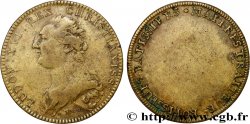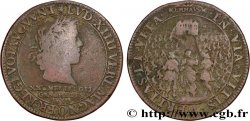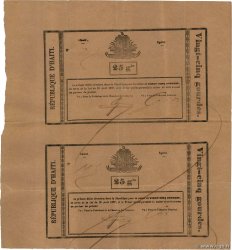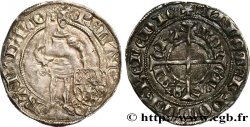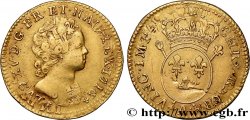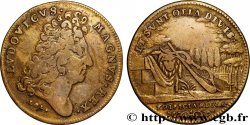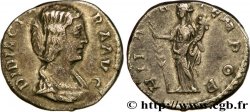Live auction - fjt_587804 - CORPORATIONS - LES SIX CORPS DES MARCHANDS DE PARIS CINQUIEME CORPS DES MARCHANDS LES BONNETIERS 1758
Sie müssen angeschlossen sein und von cgb.fr genehmigt werden, um in einer E-Auktion teilzunehmen.Melden Sie sich an, um zu wetten..Die Kontobestätigungen sind innerhalb von 48 Stunden nach Ihrer Anmeldung gemacht.Warten Sie nicht bis die letzten zwei Tage vor dem Abschluss eines Verkaufs, um Ihre Registrierung abzuschließen. Klickend "BIETEN" verpflichten Sie sich vertraglich, diesen Artikel zu kaufen und Sie nehmen ohne Reserve die allgemeinen Verkaufsbedingungen für den live auctions zu cgb.fr an.
Der Verkauf wird an der Zeit auf der Übersichtsseite angezeigt geschlossen werden. Angebote, die nach der Schließung Zeit empfangen sind, werden nicht gültig.
Bitte beachten Sie, dass die Fristen für die Einreichung Ihres Angebots auf unsere Server können variieren und es kann zur Ablehnung Ihres Angebots entstehen, wenn es in den letzten Sekunden des Verkaufs gesendet wird. Die Angebote sollen mit ganzer Zahl ausgeführt sein, Sie können Kommas oder des Punktes in Ihrem Angebot nicht erfassen. Bei Fragen klicken Sie hier, um einen Blick auf die FAQ Live-Auktionen.
Alle Gewinngebote unterliegen einem Aufschlag von 18 % für Verkaufskosten.
Alle Gewinngebote unterliegen einem Aufschlag von 18 % für Verkaufskosten.
| Schätzung : | 200 € |
| Preis : | 100 € |
| Höchstgebot : | 151 € |
| Verkaufsende : | 28 Juli 2020 18:39:57 |
| Bieter : | 1 Bieter |
Type : CINQUIEME CORPS DES MARCHANDS
LES BONNETIERS
Datum: 1758
Metall : Kupfer
Durchmesser : 28 mm
Stempelstellung : 6 h.
Gewicht : 7,79 g.
Rand Lisse
Seltenheitsgrad : R2
Kommentare zum Erhaltungszustand:
Qualité de frappe exceptionnelle
N° im Nachschlagewerk :
Vorderseite
Titulatur der Vorderseite LUD. XV. REX. CHRISTIANISS.
Beschreibung Vorderseite Buste à droite de Louis XV signé .
Übersetzung der Vorderseite Louis XV, roi très chrétien.
Rückseite
Titulatur der Rückseite QUANTOS. DUO. FLECTIT. IN. USUS ; À L'EXERGUE : LES. MDS. BONNETIERS. 1746.
Beschreibung Rückseite Écu aux armes des Bonnetiers : cinq navires allant à gauche sous une étoile et au-dessous de la Toison d'or couronnée.
Übersetzung der Rückseite Vers combien d'usages il les tourne tous les deux !.
Kommentare
En 1390, on comprend sous le titre de bonnetiers, les aumussiers, les mitainiers et les chapeliers. Dans les premiers temps de la fabrication appelée plus tard bonneterie, on appelait bonnet le fil de laine tissé à la main avec l'aiguille et la broche. Les bonnetiers ont le droit de vendre toutes sortes de bonnets de drap, de laine, ronds ou carrés, des bas, gants, chaussons, camisoles, caleçons, au métier, au tricot ou à l'aiguille, en soie, laine, coton, chanvre ou lin, poil de chameau ou de castor et autres pareilles matières.
Les bonnetiers étaient chargés de tisser à la main le fil de laine avec une aiguille, la bonneterie, ou à l’aide d’une broche, pour le broché ou “jersey”. On les appelait aussi chapeliers, gantiers ou mitainiers mais avec le temps le terme bonnetier devient générique. Leurs statuts sont rédigés en 1550 et confirmés en 1608. En 1660, un arrêt décide qu’ils auront préséance sur les orfèvres et seront désormais au cinquième rang des marchands, ce que rappelle les cinq navires sur leur blason ou au revers de ce jeton. En 1776, unis aux chapeliers et pelletiers ils formeront le troisième des six corps. Au XVIIIe siècle il y a environ 450 maisons de bonneterie à Paris. La devise du revers est strictement liée à la corporation des bonnetiers (F. 4872-4880b).
In 1390, the title of hosier included the almussiers, the mitteners and the hatters.. In the early days of the manufacture later called hosiery, the woolen thread woven by hand with a needle and spindle was called a bonnet.. Hosiery makers have the right to sell all kinds of cloth or woolen caps, round or square, stockings, gloves, slippers, camisoles, underpants, loomed, knitted or needle-knitted, in silk, wool, cotton, hemp or linen, camel or beaver hair and other similar materials..
Hosiery makers were responsible for weaving wool yarn by hand with a needle, hosiery, or using a spindle, for brocade or “jersey”. They were also called hatters, glovers or mitteners but over time the term hosier became generic.. Their statutes were drawn up in 1550 and confirmed in 1608. In 1660, a decree decided that they would have precedence over the goldsmiths and would henceforth be in the fifth rank of merchants, as recalled by the five ships on their coat of arms or on the reverse of this token.. In 1776, united with the hatters and furriers, they formed the third of the six corps. In the 18th century there were around 450 hosiery houses in Paris.. The motto on the reverse is strictly linked to the hosiery guild (F. 4872-4880b)
Les bonnetiers étaient chargés de tisser à la main le fil de laine avec une aiguille, la bonneterie, ou à l’aide d’une broche, pour le broché ou “jersey”. On les appelait aussi chapeliers, gantiers ou mitainiers mais avec le temps le terme bonnetier devient générique. Leurs statuts sont rédigés en 1550 et confirmés en 1608. En 1660, un arrêt décide qu’ils auront préséance sur les orfèvres et seront désormais au cinquième rang des marchands, ce que rappelle les cinq navires sur leur blason ou au revers de ce jeton. En 1776, unis aux chapeliers et pelletiers ils formeront le troisième des six corps. Au XVIIIe siècle il y a environ 450 maisons de bonneterie à Paris. La devise du revers est strictement liée à la corporation des bonnetiers (F. 4872-4880b).
In 1390, the title of hosier included the almussiers, the mitteners and the hatters.. In the early days of the manufacture later called hosiery, the woolen thread woven by hand with a needle and spindle was called a bonnet.. Hosiery makers have the right to sell all kinds of cloth or woolen caps, round or square, stockings, gloves, slippers, camisoles, underpants, loomed, knitted or needle-knitted, in silk, wool, cotton, hemp or linen, camel or beaver hair and other similar materials..
Hosiery makers were responsible for weaving wool yarn by hand with a needle, hosiery, or using a spindle, for brocade or “jersey”. They were also called hatters, glovers or mitteners but over time the term hosier became generic.. Their statutes were drawn up in 1550 and confirmed in 1608. In 1660, a decree decided that they would have precedence over the goldsmiths and would henceforth be in the fifth rank of merchants, as recalled by the five ships on their coat of arms or on the reverse of this token.. In 1776, united with the hatters and furriers, they formed the third of the six corps. In the 18th century there were around 450 hosiery houses in Paris.. The motto on the reverse is strictly linked to the hosiery guild (F. 4872-4880b)







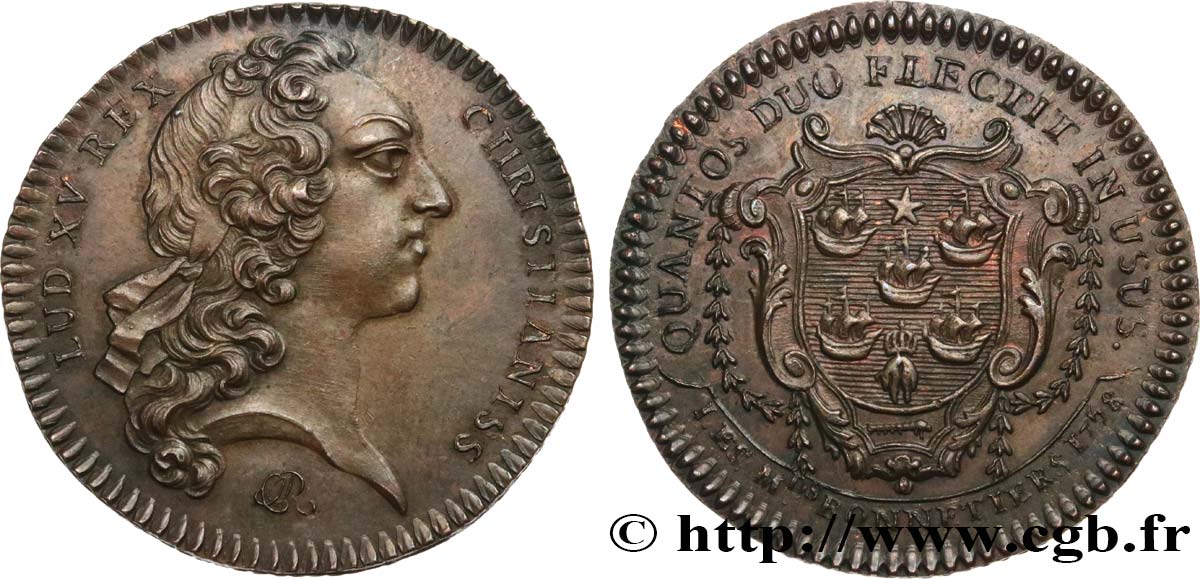
 Berichten über einen Fehler
Berichten über einen Fehler Die Seite drucken
Die Seite drucken Teilen meiner Auswahl
Teilen meiner Auswahl Stellen Sie eine Frage
Stellen Sie eine Frage Einlieferung/Verkauf
Einlieferung/Verkauf
 Details
Details


